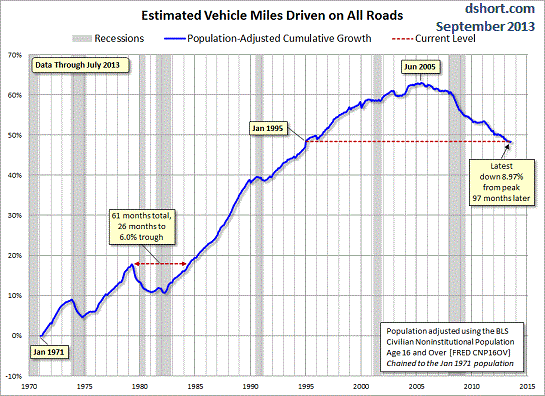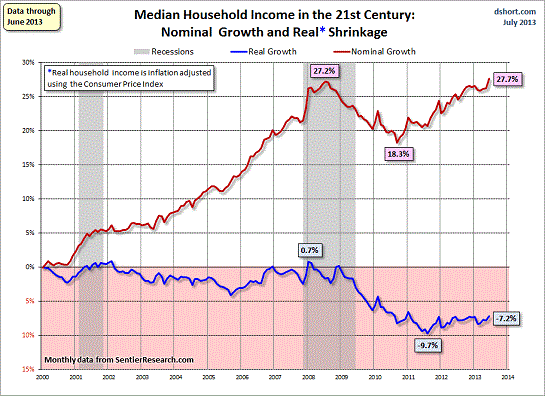Peak Walmart?
Walmart's growth model may be peaking due to structural declines in miles driven, income of its customer base and rising competition from dollar stores.
Structural declines in miles driven, middle and working-class income and rising competition from dollar stores may be leading to Peak Walmart. Walmart's model of superstores built on the edge of town with an inventory/distribution system based on high turnover may have reached the point of diminishing returns.
There are various signs of this, for example: Wal-Mart Nails The "Consumer Recovery" Coffin Shut (Zero Hedge)
Correspondent Mark G. ties together the long-term dynamics in this insightful analysis:
The proliferation of Walgreens & CVS standalone pharmacies, plus new construction standalone Dollar General and Family Dollar stores is reaching something of a critical mass. The only real difference between the first pair and the second pair of chains is Walgreens & CVS have a prescription drug department. Otherwise all four are nearly identical in format and product lines, including complete small grocery departments of dry goods and dairy products. These product lines are so low margin they haven't interested the Brown Truck Store (UPS) so far.
I've observed a rising number of young mothers pushing strollers in the neighborhoods where these standalone dollar format stores are appearing--in other words, car-less consumers.
I also note that all four chains prefer to build new stores in or on the edge of downscale neighborhoods. They do this rather than occupy the rapidly rising number of empty units at strip centers. And in point of fact Walgreens actually vacated a long-time unit at a local shopping center. CVS had built a standalone store on the corner across the street. Walgreens did the same a few miles down the road and also directly across from a Walmart Supercenter. The older Walgreen unit was then closed.
As Orlov and I learned in the USSR, you collapse with the infrastructure you have. Since consumers are having more trouble now getting to the stores, the stores are physically moving back to the consumers. Here we have stores proliferating that can be patronized and staffed by people without dedicated autos who instead walk or bike.
Car-less lower income consumers (and workers) look like major trouble for Walmart. A couple weeks ago in Fort Myers (FL) I noticed another of Walmart's "neighborhood" grocery store size format stores located in a strip center. The thought occurred to me that Walmart is doing poorly in an increasingly diverse array of activities. What's the point of moving into strip centers if Walgreens and CVS are moving out to be closer to their customers?
This theme also suggests a different angle for interpreting Walmart's tentative moves into Internet ordering and home delivery. Under this theory Walmart is principally worried about the proliferation of walking/biking distance neighborhood dollar stores.
Taken as a complete group these stores constitute a "Second Walmart" emerging to directly compete with the first Walmart at the bottom rung of the income ladder.
This makes more sense than imagining Walmart trying to compete with Amazon's wide inventory of high margin and low total national turnover items. That product array demands a compact warehouse distribution network to minimize inventory costs. Walmart's warehouse distribution network is instead optimized to throughput high turnover items.
The neighborhood dollar store story is ominous news for Walmart. The "Dollar Store" story suggests the bottom 25% of Walmart's demographic are losing their cars by force of economic circumstances. This is not something Walmart can do much about, if anything. As a result, Walmart is having its middle-class cream skimmed by Target while its base is being drained by car loss and the "Neighborhood Dollar Stores".
The question is not whether Walmart can survive another downturn but whether it can survive highly skewed recoveries like we're having.
Walmart's rise paralleled the rise of the one car per person household.The fundamental proposition of the Supercenter is you have to drive to get there. Therefore Walmart's decline will undoubtedly parallel the End of Driving.
I prepared the following spreadsheet to highlight the size and growth rate of "the second Walmart":
| Company | Ticker | Price | Employees | Stores | Annual Revenues (Billions) | Quarterly Growth |
| Target | TGT | 63.24 | 361000 | 1856 | $73.48 | 2.00% |
| Walmart | WMT | 74.65 | 2200000 | 10800 | $473 | 2.30% |
"The Second Walmart"
| Company | Ticker | Price | Employees | Stores | Annual Revenues (Billions) | Quarterly Growth |
| Walgreen | WAG | 54.85 | 171000 | 8117 | $71.35 | 3.20% |
| CVS Caremark | CVS | 57.78 | 203000 | 7458 | $123.63 | 1.70% |
| Rite Aid | RAD | 4.89 | 50730 | 4615 | $25.26 | 0.80% |
| Dollar Tree | DLTR | 57.44 | 15380 | 4700 | $7.69 | 8.80% |
| Dollar General | DG | 57 | 90500 | 10866 | $16.80 | 11.30% |
| Family Dollar | FDO | 72.57 | 33000 | 7600 | $10.25 | 9.00% |
| Big Lots | BIG | 37.19 | 13100 | 1514 | $5.42 | 0.60% |
| 576710 | 44870 | $260.40 |
Look at the revenue growth rates of the three non-pharmacy "dollar stores" in particular. (Big Lots is an older chain, and the ones I know of are all located in strip centers.) This is what is handicapping them. The three boldfaced "Dollar" stores are all opening standalone stores in residential neighborhoods. The first three drug store/variety store chains are also fairly included since Walmart also has pharmacies in most of its stores now.
For Walmart, peak driving means very serious trouble ahead. The "dollar stores" have four times as many outlets, and they're opening more at a far faster rates.Thank you, Mark, for an insightful analysis of primary trends in miles driven, income, demographics and retail. Peak Walmart may also presage Peak Mall Shopping and Peak Retail in general. The poaching of competitors' customers appears to be replacing real growth, and perhaps the impending demise of JC Penny is simply the first of many such victims of the retail shark pool.
Here are two charts of the structural declines in miles driven and household income:
Vehicle Miles Driven: Population-Adjusted Fractionally Off Its Post-Crisis Low (Doug Short)


The Nearly Free University and The Emerging Economy:
The Revolution in Higher Education
Reconnecting higher education, livelihoods and the economy

We must thoroughly understand the twin revolutions now fundamentally changing our world: The true cost of higher education and an economy that seems to re-shape itself minute to minute.
Things are falling apart--that is obvious. But why are they falling apart? The reasons are complex and global. Our economy and society have structural problems that cannot be solved by adding debt to debt. We are becoming poorer, not just from financial over-reach, but from fundamental forces that are not easy to identify. We will cover the five core reasons why things are falling apart:
 1. Debt and financialization
1. Debt and financialization2. Crony capitalism
3. Diminishing returns
4. Centralization
5. Technological, financial and demographic changes in our economy
Complex systems weakened by diminishing returns collapse under their own weight and are replaced by systems that are simpler, faster and affordable. If we cling to the old ways, our system will disintegrate. If we want sustainable prosperity rather than collapse, we must embrace a new model that is Decentralized, Adaptive, Transparent and Accountable (DATA).
We are not powerless. Once we accept responsibility, we become powerful.
Kindle: $9.95 print: $24
| Thank you, David O. (postage stamps), for your exceedingly generous contribution to this site-- I am greatly honored by your support and readership. |



























